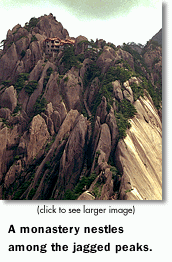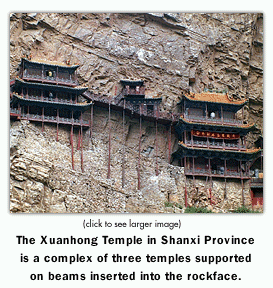 The result of this ancient architecture of wonder is the production of a
form of "silent music"-a sense of place, space and time that Foit-Albert
described as "awful," "enthralling" and "transcendent."
The result of this ancient architecture of wonder is the production of a
form of "silent music"-a sense of place, space and time that Foit-Albert
described as "awful," "enthralling" and "transcendent." 
By PATRICIA DONOVAN
News Services Editor
An award-winning architect, UB alumnus and associate professor in the School of Architecture and Planning, Foit-Albert spent nine weeks in 1995 traveling thousands of miles (trekking much of the way) with photographer and UB alumnus John Valentino and a Chinese architectural scholar with whom she is writing a book.
Together, they visited some of the most amazing, remote and mysterious works of architecture ever constructed, many of which are in their last year of existence. They are scheduled to be submerged in floods which will be produced by a massive dam, part of the Yangtze River Project.
Valentine's detailed and evocative photographs are presented with text by Foit-Albert in an exhibit, "Architecture of Heaven and Earth" that will run through Feb. 21 in the James Dyett Gallery, 334 Hayes Hall, South Campus. The exhibition is sponsored by the School of Architecture and Planning. Gallery hours are Mon.-Fri., 9 a.m.-5 p.m.
Like Foit-Albert's lectures and writing, the exhibit explores the philosophical tenets so beautifully articulated in these splendid and unique structures. Each monastery, pagoda, temple and nunnery so keenly recollected in Valentine's photos is notable for the way in which it communes with what at times appears to be a particularly inhospitable environment. Some buildings are jewel-like aeries perched on the very tips of rugged, windblown mountains. Others are strung along cliff faces or seem to meld into nearly inaccessible ravines or incorporate natural outcroppings as roofs, stairs, gates and entranceways.
The architects designed and built these structures according to ancient philosophical tenets familiar to us in terms like "fen-shui," "yin/yang" and "ch'i." Thus the ravine becomes the building, the building is a cave, the landscape itself takes the form of a flying dragon or a giant turtle rising from the morning mist to embrace the sacred site itself.
 The result of this ancient architecture of wonder is the production of a
form of "silent music"-a sense of place, space and time that Foit-Albert
described as "awful," "enthralling" and "transcendent."
The result of this ancient architecture of wonder is the production of a
form of "silent music"-a sense of place, space and time that Foit-Albert
described as "awful," "enthralling" and "transcendent."
The exhibit opens with a few of more than 130 sacred and historical structures scheduled to be submerged when the massive Three Gorges Dam of the Yangtze River Project is complete; the project is now in its final construction phase. Some of the sites that will disappear date to the Neolithic era; others are of historic and even mythic significance.
They are situated along the middle reaches of the Yangtze in central China, to which Foit-Albert and her group traveled. The dam project, which she said has produced rancorous dispute in China, will displace nearly 1.5 million people at the same time it inundates a section of the scenic Yangtze River Valley, now believed by archaeologists to rival the Yellow River Valley 300 miles to the north in its importance to the study of the origins of the Chinese people.
Among the treasures to be flooded this year is the 12-story Shibaozai pagoda, which "leans" on a 330-by-60-foot outcropping in the Xiling Gorge. Its internal staircase leads to the mountain summit where 16th-century Ming Emperor Wan Li built a temple courtyard to memorialize remains of the Buddha.
Many legends surround this site, including one about the "Duck's Hole," which penetrates from the temple courtyard above to the river below, emitting ch'i (the ethereal substance of which all things are composed) as a mysterious mist that fortifies the connection of earth to heaven and heaven to earth.
The exhibition ends with photographs of the endangered sites. In between, the viewer can explore a broad range of astonishing Chinese buildings. Some reflect the design pageantry of Beijing's Forbidden City. Others are isolated "presences" built thousands of years ago but still occupied.
Site photographs illustrate several themes around which the exhibit was designed. One of those themes is the concept of the "Mystic Mountain" in architecture.
"Mystic Mountain" is explained by Foit-Albert as an articulation of the endless interaction of the feminine principle of yin and the masculine principle yang. It involves the belief, she said, that the mountain reaching up to heaven is the dwelling place of the heavenly supernatural on earth; the place where heaven and earth meet and from which all directions emanate.
Because they provide channels for communication between the kingdom of heaven and the kingdom of earth, Daoists consider mountain tops the dwelling place of the immortals and named 36 heavenly caves and 72 blessed mountain top sites. The Buddhists established four of the most famous of China's mountains as their Holy Land and developed them with hundreds of temples. Many Buddhist sites are linked to Daoist sites by Confucian "bridges." Confucianism is understood to harmoniously marry the two earlier traditions.
In one case, a Confucian school connects a Buddhist temple to a Daoist shrine via a series of literal and metaphorical bridges. The structures are strung out along a sheer rock face on long, slender pillars, a living example of the relationships among man, earth and the spiritual realm.
Foit-Albert points out that the buildings are placed in nature in a way that the visitor's concentration on the natural landscape coordinates her metaphysical mind with the mysterious world. This principle is summed up for her in the Confucian saying, "Heaven and Earth grow with me simultaneously and all things are one with me"-a principal tenet of spiritual practice in many major world religions throughout history.
This careful "placing" of a building is the practice of "feng-shui" which Foit-Albert calls "a form of sacred geomancy." Now popular among well-heeled southern Californians, feng-shui is the art of siting houses, religious and corporate temples, graveyards and cities in the most propitious manner in any natural setting.
The concept of feng-shui is codified in the Chinese doctrine of "wind and water," Foit-Albert says. "It considers the interaction between yin and yang, the mutual promotion and restraint among the five elements, and the flowing and exchanging of ch'i, the most important factor within the natural environment." The exhibition illustrates this cosmic connection of yin and yang with the buildings' interplay of heaven and earth, interiority and exteriority, masculinities and femininities, activity and passivity, light and dark, sun and moon.
The interrelatedness of site, structure and symbol are covered in the exhibit as well, along with discourse about caves and architecture, water and architecture and a section on the expression of ch'i in building interiors. In the text Foit-Albert discusses how the Chinese express ch'i and direct it within the interior space by "remembering" manifestations of natural imagery in decorated surfaces such as screens and altars; in interior gardens, pools, sculptures and in cascades of tumbling water.
The exhibit features a few interesting artifacts with which the architect returned from China. These include sections of a few hand-carved balusters and perhaps, most telling, a large, weathered wood carving-from a roof, perhaps, or a garden-of "Lions Playing the Ball," a visual metaphor for the discourse between Daoism and Buddhism in Confucianism, which mediates between Daoist and Buddhist spaces and philosophies.
Here the "third element," Confucianism (the ball), is thrust between the Daoism (the lion) and Buddhism (the lioness) as a playful symbolic reference to the relationship among the three that finds expression in centuries of breathtaking architecture as it has in many other aspects of the Chinese aesthetic experience.
